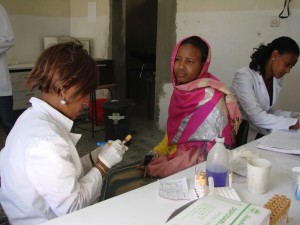The following post is brought to you by Steve Lewis, our Global Health Advocacy Manager. Following on from our delegation post, Steve describes our visit to one of Addis Ababa’s health centres:
In February I travelled to Ethiopia with RESULTS staff and five UK parliamentarians to see health programmes and assess the effectiveness of UK support for poverty reduction in the country. The trip was a fascinating mixture of meetings with the ‘highest’ and the ‘lowest’ in the chain of support for poverty-related health programmes.
 We met with DFID officials, the Ethiopia Minister of Health and officials at the Africa Union (AU). The meeting with the AU took place in their sleek new building constructed the Chinese government. But while these meetings provided us facts and figures, it was hard to understand the impact of the work on the ground level.
We met with DFID officials, the Ethiopia Minister of Health and officials at the Africa Union (AU). The meeting with the AU took place in their sleek new building constructed the Chinese government. But while these meetings provided us facts and figures, it was hard to understand the impact of the work on the ground level.
We were able to see how this work affected communities during a site visit conducted by AMREF to local water and sanitation projects as well as to a local health centre in a poor and crowded urban area of Addis Ababa, the capital of Ethiopia. Queues of patients waited on benches in the open air, waiting to be seen by nurses and staff who work to diagnose and treat common illnesses such as tuberculosis, pneumonia and stunting (malnutrition). The health centre had no actual doctor on site – Ethiopia has an acute shortage of doctors and most other senior health personnel.

I found the most encouraging part of the visit to be a meeting with a support group of women with HIV/AIDS. On previous visits to Africa a few years ago, I had seen high levels of stigma against people living with HIV. No one wanted to admit it, and no one wanted to know. But in this health centre a crowded group of women in multi-coloured dresses sat around a table and waited patiently to tell us their stories. They told us they meet every Wednesday morning, and their numbers are growing.
As children crawled around the floor, the women were not shy to tell us about their lives. The health centre has diagnosed them with HIV but now provides daily drugs to keep the impact at bay (anti-retrovirals or ARVs). Some years ago a woman would have had to take around a dozen pills a day, with severe side effects, but now they take just three pills.
“What about the side effects?” I asked.
A confident young woman told us she suffers no side effects and feels perfectly healthy. “These ARVs have kept me alive,” she said simply.
The ARVs are bought in bulk for Ethiopia by the Global Fund for AIDS, Tuberculosis and Malaria (GFATM). Our UK delegation were proud that the UK is one of the biggest donors to the Global Fund.

The other huge advance in medical technology has been vast improvements in ‘Prevention of Mother to Child infection’ (PMTCT). Only ten years ago most babies born to HIV positive women would have been born HIV-positive themselves and would have quickly died. Now, a simple regimen of check-ups and a daily pill at the crucial time means nearly all babies are born HIV-negative. They do not have HIV and have the chance to grow up healthy. This health centre provides 46 women with anti-retrovirals and 44 of them have given birth to healthy children. Two were born with HIV, of which one baby passed away. The HIV-positive child comes with his mother to this support group.
The women give each other emotional support to come to terms with living with HIV. But they hold their heads up and seem happy to talk to strangers about their lives. Our parliamentarians asked many inquiring questions but the women were not fazed.
– “How many children do you have?”
– “Two, and that’s enough…”
– “Do you husbands come to the support group meeting?”
– “No, and that’s the way we like it.”
– “What hopes do you have for your daughter when she grows up?”
– “I would like her to be a doctor.”
The visit provided an excellent example of how Ethiopia is dealing with tough health challenges and effectively demonstrated that UK aid money is being put to good use.